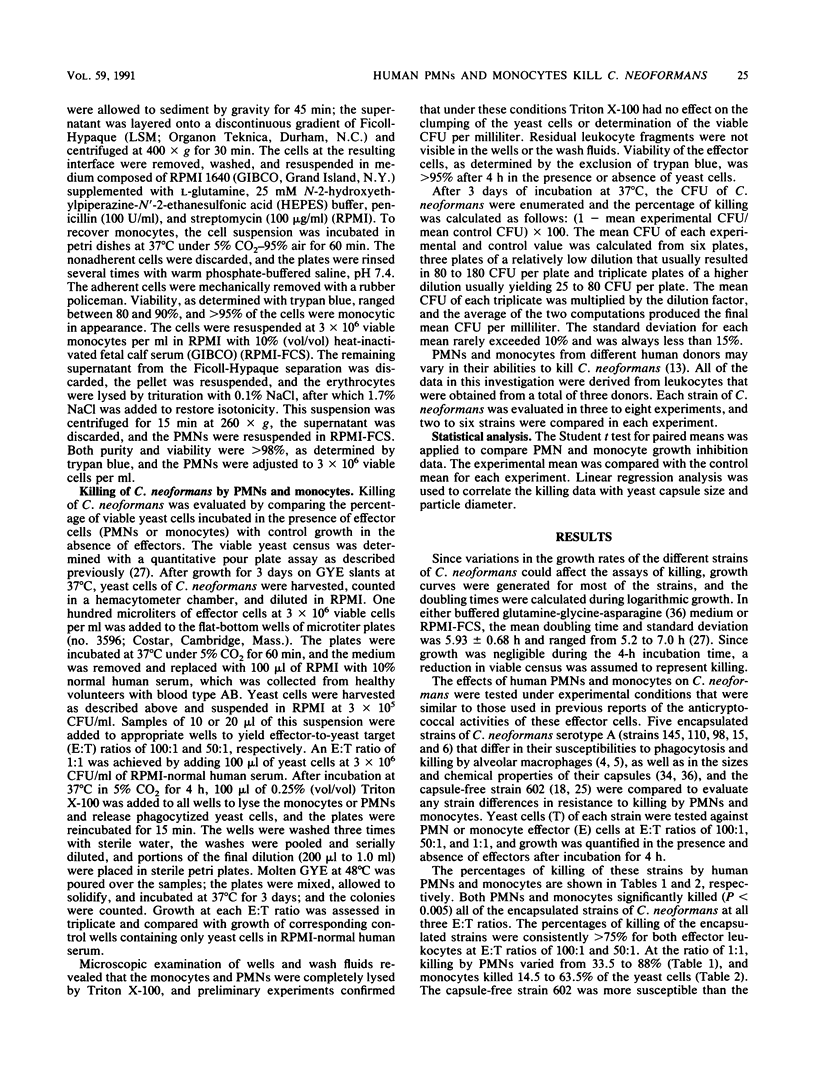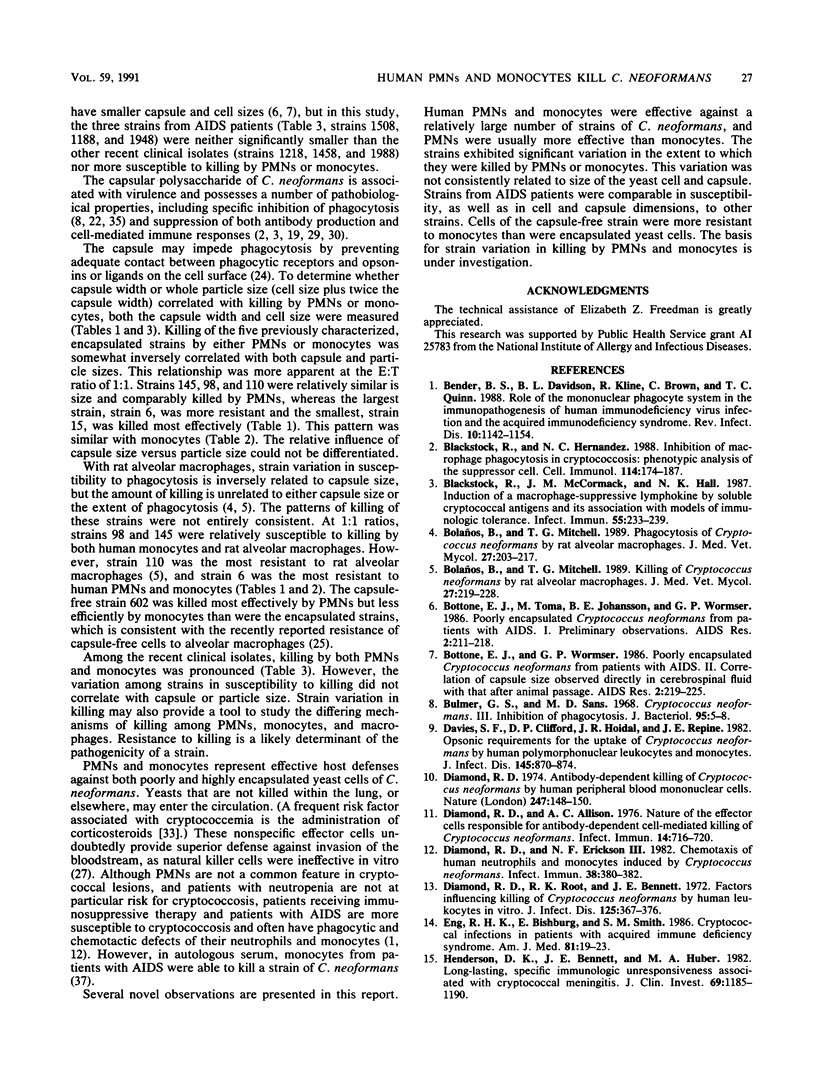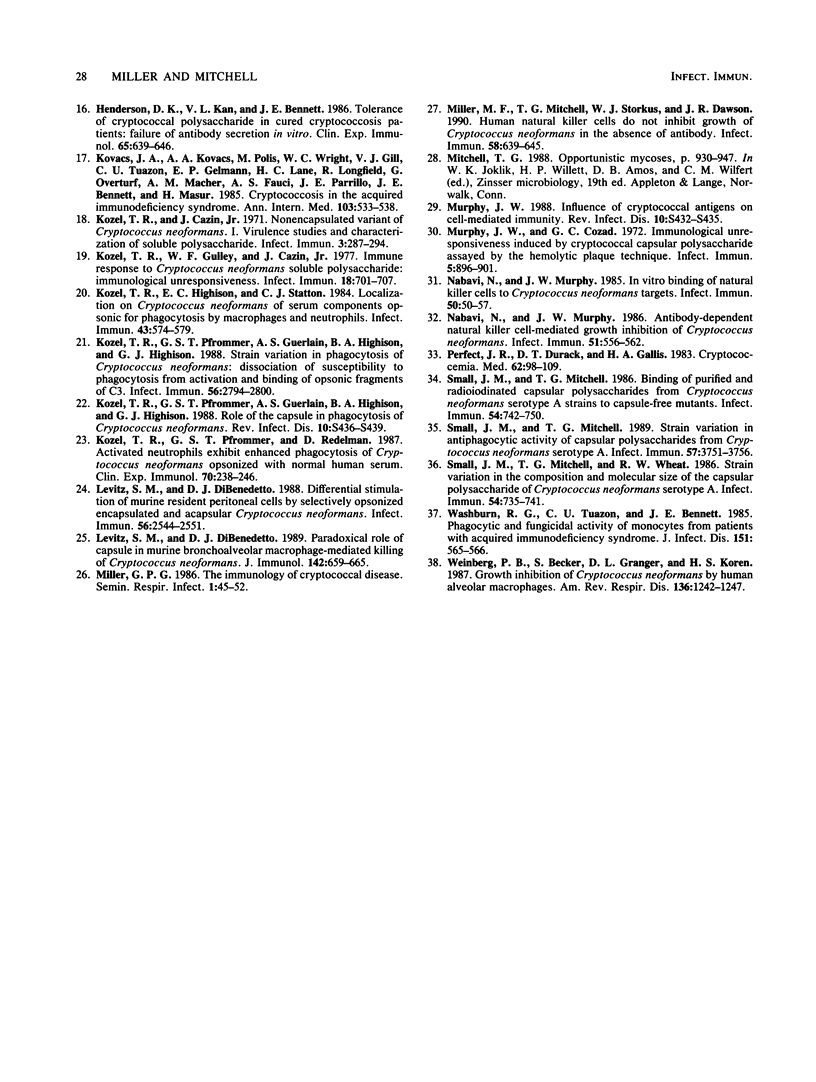Abstract
The susceptibility of various strains of Cryptococcus neoformans to killing by human polymorphonuclear leukocytes (PMNs) and monocytes was investigated. Five previously characterized strains of C. neoformans serotype A, a capsule-free mutant, and six recent clinical isolates were compared. PMNs and monocytes were isolated from normal peripheral blood and allowed to adhere to the flat-bottom wells of microtiter plates. Yeast cells of C. neoformans were added in the presence of normal human serum, and the plates were incubated at 37 degrees C. After 4 h, killing was determined by comparing the quantitative plate counts of viable yeast cells in experimental wells with counts in control wells containing yeast cells in the absence of leukocytes. No appreciable growth of yeast cells occurred in the wells during the incubation period. Both PMNs and monocytes effectively killed yeast cells at effector-to-target ratios as low as 1:1, although monocytes failed to kill the capsule-free strain 602 at a 1:1 ratio. With 9 of 12 strains, PMNs killed C. neoformans more effectively than did monocytes. Significant interstrain variation in killing occurred for both monocytes and PMNs, and the recent, clinical isolates were more resistant to killing by monocytes and PMNs than were the previously characterized strains. The extent to which different strains were killed by monocytes and PMNs was not consistently related to the size of the capsule or the entire cell. Normal PMNs and monocytes are remarkably effective in killing strains of C. neoformans in the absence of specific antibody and appear to constitute a significant defense mechanism in the peripheral circulation.
Full text
PDF




Selected References
These references are in PubMed. This may not be the complete list of references from this article.
- Bender B. S., Davidson B. L., Kline R., Brown C., Quinn T. C. Role of the mononuclear phagocyte system in the immunopathogenesis of human immunodeficiency virus infection and the acquired immunodeficiency syndrome. Rev Infect Dis. 1988 Nov-Dec;10(6):1142–1154. doi: 10.1093/clinids/10.6.1142. [DOI] [PubMed] [Google Scholar]
- Blackstock R., Hernandez N. C. Inhibition of macrophage phagocytosis in cryptococcosis: phenotypic analysis of the suppressor cell. Cell Immunol. 1988 Jun;114(1):174–187. doi: 10.1016/0008-8749(88)90264-x. [DOI] [PubMed] [Google Scholar]
- Blackstock R., McCormack J. M., Hall N. K. Induction of a macrophage-suppressive lymphokine by soluble cryptococcal antigens and its association with models of immunologic tolerance. Infect Immun. 1987 Jan;55(1):233–239. doi: 10.1128/iai.55.1.233-239.1987. [DOI] [PMC free article] [PubMed] [Google Scholar]
- Bolaños B., Mitchell T. G. Killing of Cryptococcus neoformans by rat alveolar macrophages. J Med Vet Mycol. 1989;27(4):219–228. [PubMed] [Google Scholar]
- Bolaños B., Mitchell T. G. Phagocytosis of Cryptococcus neoformans by rat alveolar macrophages. J Med Vet Mycol. 1989;27(4):203–217. [PubMed] [Google Scholar]
- Bottone E. J., Toma M., Johansson B. E., Wormser G. P. Poorly encapsulated Cryptococcus neoformans from patients with AIDS. I: Preliminary observations. AIDS Res. 1986 Summer;2(3):211–218. doi: 10.1089/aid.1.1986.2.211. [DOI] [PubMed] [Google Scholar]
- Bottone E. J., Wormser G. P. Poorly encapsulated Cryptococcus neoformans from patients with AIDS. II. Correlation of capsule size observed directly in cerebrospinal fluid with that after animal passage. AIDS Res. 1986 Summer;2(3):219–225. doi: 10.1089/aid.1.1986.2.219. [DOI] [PubMed] [Google Scholar]
- Bulmer G. S., Sans M. D. Cryptococcus neoformans. 3. Inhibition of phagocytosis. J Bacteriol. 1968 Jan;95(1):5–8. doi: 10.1128/jb.95.1.5-8.1968. [DOI] [PMC free article] [PubMed] [Google Scholar]
- Davies S. F., Clifford D. P., Hoidal J. R., Repine J. E. Opsonic requirements for the uptake of Cryptococcus neoformans by human polymorphonuclear leukocytes and monocytes. J Infect Dis. 1982 Jun;145(6):870–874. doi: 10.1093/infdis/145.6.870. [DOI] [PubMed] [Google Scholar]
- Diamond R. D., Allison A. C. Nature of the effector cells responsible for antibody-dependent cell-mediated killing of Cryptococcus neoformans. Infect Immun. 1976 Sep;14(3):716–720. doi: 10.1128/iai.14.3.716-720.1976. [DOI] [PMC free article] [PubMed] [Google Scholar]
- Diamond R. D. Antibody-dependent killing of Cryptococcus neopormans by human peripheral blood mononuclear cells. Nature. 1974 Jan 18;247(5437):148–150. doi: 10.1038/247148a0. [DOI] [PubMed] [Google Scholar]
- Diamond R. D., Erickson N. F., 3rd Chemotaxis of human neutrophils and monocytes induced by Cryptococcus neoformans. Infect Immun. 1982 Oct;38(1):380–382. doi: 10.1128/iai.38.1.380-382.1982. [DOI] [PMC free article] [PubMed] [Google Scholar]
- Diamond R. D., Root R. K., Bennett J. E. Factors influencing killing of Cryptococcus neoformans by human leukocytes in vitro. J Infect Dis. 1972 Apr;125(4):367–376. doi: 10.1093/infdis/125.4.367. [DOI] [PubMed] [Google Scholar]
- Eng R. H., Bishburg E., Smith S. M., Kapila R. Cryptococcal infections in patients with acquired immune deficiency syndrome. Am J Med. 1986 Jul;81(1):19–23. doi: 10.1016/0002-9343(86)90176-2. [DOI] [PubMed] [Google Scholar]
- Henderson D. K., Bennett J. E., Huber M. A. Long-lasting, specific immunologic unresponsiveness associated with cryptococcal meningitis. J Clin Invest. 1982 May;69(5):1185–1190. doi: 10.1172/JCI110555. [DOI] [PMC free article] [PubMed] [Google Scholar]
- Henderson D. K., Kan V. L., Bennett J. E. Tolerance to cryptococcal polysaccharide in cured cryptococcosis patients: failure of antibody secretion in vitro. Clin Exp Immunol. 1986 Sep;65(3):639–646. [PMC free article] [PubMed] [Google Scholar]
- Kovacs J. A., Kovacs A. A., Polis M., Wright W. C., Gill V. J., Tuazon C. U., Gelmann E. P., Lane H. C., Longfield R., Overturf G. Cryptococcosis in the acquired immunodeficiency syndrome. Ann Intern Med. 1985 Oct;103(4):533–538. doi: 10.7326/0003-4819-103-4-533. [DOI] [PubMed] [Google Scholar]
- Kozel T. R., Cazin J. Nonencapsulated Variant of Cryptococcus neoformans I. Virulence Studies and Characterization of Soluble Polysaccharide. Infect Immun. 1971 Feb;3(2):287–294. doi: 10.1128/iai.3.2.287-294.1971. [DOI] [PMC free article] [PubMed] [Google Scholar]
- Kozel T. R., Gulley W. F., Cazin J., Jr Immune response to Cryptococcus neoformans soluble polysaccharide: immunological unresponsiveness. Infect Immun. 1977 Dec;18(3):701–707. doi: 10.1128/iai.18.3.701-707.1977. [DOI] [PMC free article] [PubMed] [Google Scholar]
- Kozel T. R., Highison B., Stratton C. J. Localization on encapsulated Cryptococcus neoformans of serum components opsonic for phagocytosis by macrophages and neutrophils. Infect Immun. 1984 Feb;43(2):574–579. doi: 10.1128/iai.43.2.574-579.1984. [DOI] [PMC free article] [PubMed] [Google Scholar]
- Kozel T. R., Pfrommer G. S., Guerlain A. S., Highison B. A., Highison G. J. Role of the capsule in phagocytosis of Cryptococcus neoformans. Rev Infect Dis. 1988 Jul-Aug;10 (Suppl 2):S436–S439. doi: 10.1093/cid/10.supplement_2.s436. [DOI] [PubMed] [Google Scholar]
- Kozel T. R., Pfrommer G. S., Guerlain A. S., Highison B. A., Highison G. J. Strain variation in phagocytosis of Cryptococcus neoformans: dissociation of susceptibility to phagocytosis from activation and binding of opsonic fragments of C3. Infect Immun. 1988 Nov;56(11):2794–2800. doi: 10.1128/iai.56.11.2794-2800.1988. [DOI] [PMC free article] [PubMed] [Google Scholar]
- Kozel T. R., Pfrommer G. S., Redelman D. Activated neutrophils exhibit enhanced phagocytosis of Cryptococcus neoformans opsonized with normal human serum. Clin Exp Immunol. 1987 Oct;70(1):238–246. [PMC free article] [PubMed] [Google Scholar]
- Levitz S. M., DiBenedetto D. J. Differential stimulation of murine resident peritoneal cells by selectively opsonized encapsulated and acapsular Cryptococcus neoformans. Infect Immun. 1988 Oct;56(10):2544–2551. doi: 10.1128/iai.56.10.2544-2551.1988. [DOI] [PMC free article] [PubMed] [Google Scholar]
- Levitz S. M., DiBenedetto D. J. Paradoxical role of capsule in murine bronchoalveolar macrophage-mediated killing of Cryptococcus neoformans. J Immunol. 1989 Jan 15;142(2):659–665. [PubMed] [Google Scholar]
- Miller G. P. The immunology of cryptococcal disease. Semin Respir Infect. 1986 Mar;1(1):45–52. [PubMed] [Google Scholar]
- Miller M. F., Mitchell T. G., Storkus W. J., Dawson J. R. Human natural killer cells do not inhibit growth of Cryptococcus neoformans in the absence of antibody. Infect Immun. 1990 Mar;58(3):639–645. doi: 10.1128/iai.58.3.639-645.1990. [DOI] [PMC free article] [PubMed] [Google Scholar]
- Murphy J. W., Cozad G. C. Immunological unresponsiveness induced by cryptococcal capsular polysaccharide assayed by the hemolytic plaque technique. Infect Immun. 1972 Jun;5(6):896–901. doi: 10.1128/iai.5.6.896-901.1972. [DOI] [PMC free article] [PubMed] [Google Scholar]
- Murphy J. W. Influence of cryptococcal antigens on cell-mediated immunity. Rev Infect Dis. 1988 Jul-Aug;10 (Suppl 2):S432–S435. doi: 10.1093/cid/10.supplement_2.s432. [DOI] [PubMed] [Google Scholar]
- Nabavi N., Murphy J. W. Antibody-dependent natural killer cell-mediated growth inhibition of Cryptococcus neoformans. Infect Immun. 1986 Feb;51(2):556–562. doi: 10.1128/iai.51.2.556-562.1986. [DOI] [PMC free article] [PubMed] [Google Scholar]
- Nabavi N., Murphy J. W. In vitro binding of natural killer cells to Cryptococcus neoformans targets. Infect Immun. 1985 Oct;50(1):50–57. doi: 10.1128/iai.50.1.50-57.1985. [DOI] [PMC free article] [PubMed] [Google Scholar]
- Perfect J. R., Durack D. T., Gallis H. A. Cryptococcemia. Medicine (Baltimore) 1983 Mar;62(2):98–109. doi: 10.1097/00005792-198303000-00003. [DOI] [PubMed] [Google Scholar]
- Small J. M., Mitchell T. G. Binding of purified and radioiodinated capsular polysaccharides from Cryptococcus neoformans serotype A strains to capsule-free mutants. Infect Immun. 1986 Dec;54(3):742–750. doi: 10.1128/iai.54.3.742-750.1986. [DOI] [PMC free article] [PubMed] [Google Scholar]
- Small J. M., Mitchell T. G. Strain variation in antiphagocytic activity of capsular polysaccharides from Cryptococcus neoformans serotype A. Infect Immun. 1989 Dec;57(12):3751–3756. doi: 10.1128/iai.57.12.3751-3756.1989. [DOI] [PMC free article] [PubMed] [Google Scholar]
- Small J. M., Mitchell T. G., Wheat R. W. Strain variation in composition and molecular size of the capsular polysaccharide of Cryptococcus neoformans serotype A. Infect Immun. 1986 Dec;54(3):735–741. doi: 10.1128/iai.54.3.735-741.1986. [DOI] [PMC free article] [PubMed] [Google Scholar]
- Washburn R. G., Tuazon C. U., Bennett J. E. Phagocytic and fungicidal activity of monocytes from patients with acquired immunodeficiency syndrome. J Infect Dis. 1985 Mar;151(3):565–566. doi: 10.1093/infdis/151.3.565. [DOI] [PubMed] [Google Scholar]
- Weinberg P. B., Becker S., Granger D. L., Koren H. S. Growth inhibition of Cryptococcus neoformans by human alveolar macrophages. Am Rev Respir Dis. 1987 Nov;136(5):1242–1247. doi: 10.1164/ajrccm/136.5.1242. [DOI] [PubMed] [Google Scholar]


